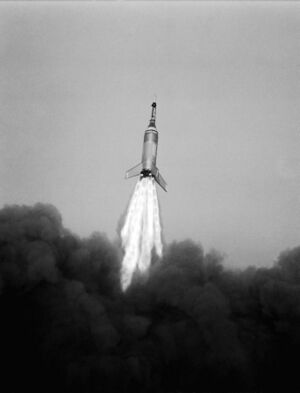Engineering:Little Joe 6
From HandWiki
Short description: Early Mercury System Test
 Little Joe 6 launch Oct. 4, 1959 | |
| Mission type | Abort test |
|---|---|
| Operator | NASA |
| Mission duration | 5 minutes, 10 seconds |
| Distance travelled | 127 kilometres (79 mi) |
| Apogee | 60 kilometres (37 mi) |
| Spacecraft properties | |
| Spacecraft type | Mercury boilerplate |
| Manufacturer | McDonnell Aircraft |
| Launch mass | 1,134 kilograms (2,500 lb) |
| Start of mission | |
| Launch date | October 4, 1959, 10:00 UTC |
| Rocket | Little Joe |
| Launch site | Wallops LA-1 |
| End of mission | |
| Landing date | October 4, 1959, 10:05 UTC |

Project Mercury Abort Tests | |
The Little Joe 6 was a launch escape system test of the Mercury spacecraft, conducted as part of the U.S. Mercury program. The mission used a boilerplate Mercury spacecraft. The mission was launched October 4, 1959, from Wallops Island, Virginia.[1] The Little Joe 6 flew to an apogee of 60 kilometres (37 mi) and a range of 127 kilometres (79 mi). The mission lasted 5 minutes 10 seconds. Maximum speed was 1,375 metres per second (3,075 mph) and acceleration was 5.9 g (58 m/s²). Payload 1,134 kilograms (2,500 lb).[2]
See also
References
- ↑ "Historical Snapshot. Little Joe Launch Vehicle". https://www.boeing.com/history/products/little-joe-launch-vehicle.page.
- ↑ "Chapter 7: Little Joe Series". This New Ocean. NASA. https://history.nasa.gov/SP-4201/ch7-7.htm. Retrieved March 26, 2023.
![]() This article incorporates public domain material from websites or documents of the National Aeronautics and Space Administration.
This article incorporates public domain material from websites or documents of the National Aeronautics and Space Administration.
 |


